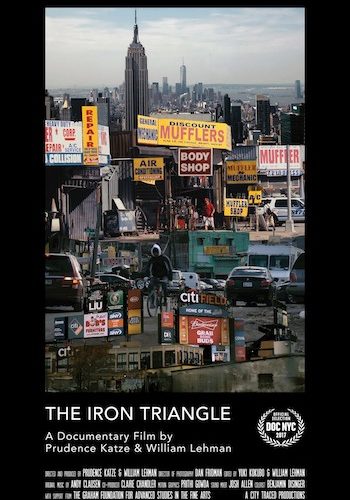Following up on a landscape previously documented in Ramin Bahrani’s brilliant narrative feature Chop Shop, directors Prudence Katze and William Lehman chronicle the multiyear eviction process in The Iron Triangle as small business owners in Willets Point are forced out in the name of urban renewal. From the outside, Willets Point looks like a third world country sitting next to Citi Field, a network of deteriorating roads, auto body shops, and junkyards; it’s certainly not pretty, even if it’s functional.

The Iron Triangle is a largely political documentary focusing on the forces that threaten the way of life in a community founded largely by Italian and Greek immigrants to provide cheap, efficient automobile service at a fair price. Transactional in nature, Katze and Lehamn miss an opportunity to dive into the personal lives of the workers impacted by the move, utilizing talking heads–including academics and the past head of the New York City Economic Development Corporation (NYCEDC)–instead of deeply embedding themselves within the culture of Willets Point–both the workers and small business owners. The Iron Triangle is indeed a blight in a vibrant neighborhood and Ramin Bahrani was able to find beauty in an ethnographic narrative that simply is not present here. The film is more or less about the land grab and the changing character of the city during the Bloomberg administration as the powerful NYCEDC spends millions “studying” the issues with plans to relocate at one point 10% of the businesses at Willis Point.
The NYCEDC, a non-profit funded with city dollars, sets the agenda for urban renewal and focuses its sights on bringing retail and housing to the region despite protests from those working in the Iron Triangle who are intimidated by the NYPD when protesting. This truly is a tale of two New York Cities as the city allows the roads of Willets Point to deteriorate, claiming they were just repaved years ago.

The Iron Triangle is as cold a film as the place it documents, relying too heavily on voices and insights of urban planners and academics as they offer spare historical context on Willets Point and the surrounding neighborhoods. Indeed, it’s not an easy place to get to the truth of in this context, yet a film with the luxury of more time (the neighborhood is essentially now behind a fence as matters get settled) might document the people who go to work, rather than the looming forces looking instead to bulldoze the neighborhood for a Lord & Taylor and Cheesecake Factory across from Citi Field. Indeed, the fatal flaw of The Iron Triangle is that it wastes a vital, interesting story and engaging characters by offering too few voices.
The Iron Triangle premiered at DOC NYC.

